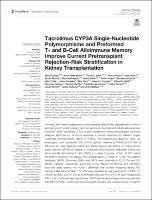| dc.contributor | Vall d'Hebron Barcelona Hospital Campus |
| dc.contributor.author | Crespo Gimeno, Elena Isabel |
| dc.contributor.author | Vidal-Alabró, Anna |
| dc.contributor.author | Jouve, Thomas |
| dc.contributor.author | Fontova, Pere |
| dc.contributor.author | Stein, Maik |
| dc.contributor.author | Mocka, Sonila |
| dc.contributor.author | Meneghini. Maria Antonia Emilia |
| dc.contributor.author | Torija Recasens, Alba |
| dc.contributor.author | Donadeu Casassas, Laura |
| dc.contributor.author | Moreso Mateos, Francesc |
| dc.contributor.author | Bestard Matamoros, Oriol |
| dc.date.accessioned | 2022-09-16T09:10:32Z |
| dc.date.available | 2022-09-16T09:10:32Z |
| dc.date.issued | 2022-06 |
| dc.identifier.citation | Crespo E, Vidal-Alabró A, Jouve T, Fontova P, Stein M, Mocka S, et al. Tacrolimus CYP3A Single-Nucleotide Polymorphisms and Preformed T- and B-Cell Alloimmune Memory Improve Current Pretransplant Rejection-Risk Stratification in Kidney Transplantation. Front Immunol. 2022 Jun;13:869554. |
| dc.identifier.issn | 1664-3224 |
| dc.identifier.uri | https://hdl.handle.net/11351/8204 |
| dc.description | Acute rejection; Genetics; Immunobiology |
| dc.description.abstract | Achieving fast immunosuppression blood exposure after kidney transplantation is key to abrogating both preformed and de novo anti-donor humoral and cellular alloresponses. However, while tacrolimus (TAC) is the cornerstone immunosuppressant inhibiting adaptive alloimmunity, its blood exposure is directly impacted by different single-nucleotide polymorphisms (SNPs) in CYP3A TAC-metabolizing enzymes. Here, we investigated how functional TAC-CYP3A genetic variants (CYP3A4*22/CYP3A5*3) influence the main baseline clinical and immunological risk factors of biopsy-proven acute rejection (BPAR) by means of preformed donor-specific antibodies (DSAs) and donor-specific alloreactive T cells (DSTs) in a large European cohort of 447 kidney transplants receiving TAC-based immunosuppression. A total of 70 (15.7%) patients developed BPAR. Preformed DSAs and DSTs were observed in 12 (2.7%) and 227 (50.8%) patients, respectively. According to the different CYP3A4*22 and CYP3A5*3 functional allele variants, we found 4 differential new clusters impacting fasting TAC exposure after transplantation; 7 (1.6%) were classified as high metabolizers 1 (HM1), 71 (15.9%) as HM2, 324 (72.5%) as intermediate (IM), and 45 (10.1%) as poor metabolizers (PM1). HM1/2 showed significantly lower TAC trough levels and higher dose requirements than IM and PM (p < 0.001) and more frequently showed TAC underexposure (<5 ng/ml). Multivariate Cox regression analyses revealed that CYP3A HM1 and IM pharmacogenetic phenotypes (hazard ratio (HR) 12.566, 95% CI 1.99-79.36, p = 0.007, and HR 4.532, 95% CI 1.10-18.60, p = 0.036, respectively), preformed DSTs (HR 3.482, 95% CI 1.99-6.08, p < 0.001), DSAs (HR 4.421, 95% CI 1.63-11.98, p = 0.003), and delayed graft function (DGF) (HR 2.023, 95% CI 1.22-3.36, p = 0.006) independently predicted BPAR. Notably, a significant interaction between T-cell depletion and TAC underexposure was observed, showing a reduction of the BPAR risk (HR 0.264, 95% CI 0.08-0.92, p = 0.037). Such variables except for DSAs displayed a higher predictive risk for the development of T cell-mediated rejection (TCMR). Refinement of pretransplant monitoring by incorporating TAC CYP3A SNPs with preformed DSAs as well as DSTs may improve current rejection-risk stratification and help induction treatment decision-making. |
| dc.language.iso | eng |
| dc.publisher | Frontiers Media |
| dc.relation.ispartofseries | Frontiers in Immunology;13 |
| dc.rights | Attribution 4.0 International |
| dc.rights.uri | http://creativecommons.org/licenses/by/4.0/ |
| dc.source | Scientia |
| dc.subject | Ronyons - Trasplantació |
| dc.subject | Cèl·lules B - Immunologia |
| dc.subject | Polimorfisme genètic |
| dc.subject.mesh | Polymorphism, Single Nucleotide |
| dc.subject.mesh | Kidney Transplantation |
| dc.subject.mesh | B-Lymphocytes |
| dc.title | Tacrolimus CYP3A Single-Nucleotide Polymorphisms and Preformed T- and B-Cell Alloimmune Memory Improve Current Pretransplant Rejection-Risk Stratification in Kidney Transplantation |
| dc.type | info:eu-repo/semantics/article |
| dc.identifier.doi | 10.3389/fimmu.2022.869554 |
| dc.subject.decs | polimorfismo de nucleótido único |
| dc.subject.decs | trasplante de riñón |
| dc.subject.decs | linfocitos B |
| dc.relation.publishversion | https://doi.org/10.3389/fimmu.2022.869554 |
| dc.type.version | info:eu-repo/semantics/publishedVersion |
| dc.audience | Professionals |
| dc.contributor.organismes | Institut Català de la Salut |
| dc.contributor.authoraffiliation | [Crespo E, Torija A, Donadeu L] Laboratori de Nefrologia i Trasplantament Renal, Vall d'Hebron Institut de Recerca (VHIR), Barcelona, Spain. [Vidal-Alabró A, Fontova P, Mocka S] Experimental Nephrology and Transplantation Laboratory, Instituto de Investigación Biomédica de Bellvitge (IDIBELL), Barcelona, Spain. [Jouve T] Laboratori de Nefrologia i Trasplantament Renal, Vall d'Hebron Institut de Recerca (VHIR), Barcelona, Spain. Faculty of Health, Université Grenoble Alpes, Grenoble, France. Institute for Advanced Biosciences, INSERM 1209, CNRS 5309, Grenoble, France. [Stein M] Berlin Center for Advanced Therapies (BeCAT), Berlin, Germany. Charité - Universitätsmedizin Berlin, corporate member of Freie Universität Berlin, Humboldt-Universität zu Berlin, Berlin, Germany. Berlin Institute of Health (BIH), Berlin, Germany. [Meneghini M, Bestard O] Laboratori de Nefrologia i Trasplantament Renal, Vall d'Hebron Institut de Recerca (VHIR), Barcelona, Spain. Unitat de Trasplantament Renal, Servei de Nefrologia, Vall d’Hebron Hospital, Barcelona, Spain. [Moreso F] Unitat de Trasplantament Renal, Servei de Nefrologia, Vall d’Hebron Hospital, Barcelona, Spain |
| dc.identifier.pmid | 35833145 |
| dc.identifier.wos | 000823422300001 |
| dc.rights.accessrights | info:eu-repo/semantics/openAccess |

